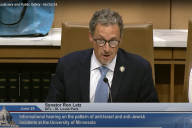You have /5 articles left.
Sign up for a free account or log in.
In the wake of the ongoing pandemic, we have seen a seismic shift in the way that students and faculty interact in and outside our classrooms. This shift has happened in a cultural time when much has been written about how we need to take care of ourselves, how we need to consider alternative perspectives and understand that technology has moved us into a world that really has never existed before in education. This has led us down a path that will forever change the face and landscape of higher education. No longer will it be considered even remotely acceptable to simply lecture to students. Students want more, faculty want more and education and society demand more.
However, all that said, if you really ask students what they want, what they need and what will help them learn, it boils down to compassion.
A recent Student Voice survey by Inside Higher Ed and College Pulse suggests that students want faculty members to consider alternative ways of teaching. They also want professors to understand that they have other demands on their time and to perhaps be flexible. And they want faculty members to consider costs when assigning materials. A college education already costs so much. Adding onto that the costs of books and other materials only adds stress to an already stressed environment.
The faculty voice, meanwhile, is very different from the student voice. What I am hearing from faculty members is that students are underprepared, less willing to take chances in class and want information in smaller, digestible nuggets. Faculty members also want to make sure they maintain “rigor.”
So what can faculty members realistically do to ensure that they are meeting the needs of students while still feeling as though they are teaching in ways that align with their goals and who they are?
Although there might be a gap between faculty and students regarding goals and objectives, I argue that the perceived difference is much smaller than it appears. There are of course differences based on educational history, access to support and past practice. Yet faculty members generally want students to succeed—and students want professors to help them do that. Here are some concepts that both students and faculty members need to think about:
- Flexibility: Students need to understand that faculty members try to teach as best they can, based on what they know about teaching. Students need to understand that not all faculty members will meet their needs exactly as desired. But professors also need to understand that the way we are doing things doesn’t always work. Professors need to be attentive to students’ needs and respond accordingly.
Faculty members should avail themselves of the services available to them via teaching and learning or faculty development centers so they have access to myriad tools to help them better interact with and instruct their students. Teaching and learning are deeply contextualized within an institution. Faculty members should be acutely aware of the culture so they can adapt and be ready to help students where they need it. And students need to be flexible, too. Sometimes a faculty member’s style would work with a tweak of study habits. Both sides need to acknowledge the differences that exist. - Communication: Students benefit from faculty members expressing what they want in a clear and concise manner so there is little in the way of misunderstanding of assignments and expectations. Students also benefit from professors knowing their names, if class sizes are small enough to permit it. Faculty members benefit from students expressing their thoughts and understanding of material and teaching approach. Open communication makes all the difference, and if it is there, faculty and students benefit.
- Feedback: Everyone benefits from feedback. It helps with all forms of communication. Faculty members should provide prompt, clear feedback to students. Students may also provide input, including whether they’ve understood their professors’ feedback and what it means to them. This helps professors and students clearly articulate their needs and thoughts.
Over all, the Student Voice survey data on academic life suggest that while higher education is changing, and rapidly so, the human touch makes all the difference. Students want ease of access. They want clarity. They want faculty members to try new things. And they want flexibility. Faculty members want students who try, who care and who are willing to work. Through communication and feedback, and with room for flexibility, students and faculty members can discover that powerful learning occurs when compassion is infused in the classroom on both sides. Everybody benefits.
Finding that space for compassion in this difficult time is admittedly challenging. However, the cost of not finding it is too high. Faculty members and students need to work together to develop strategies to provide mutual benefit to all. The future of higher education depends on it.








